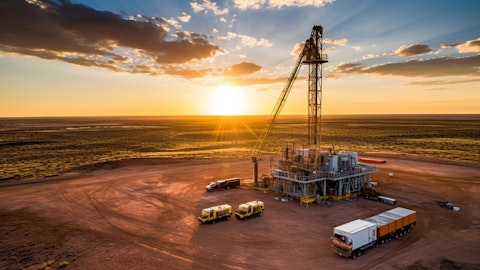[Indiscernible] and they are spaced in our wider spacing pattern. So ultimately, we do not anticipate seeing any kind of degradation or differential performance that’s negative as a result of the horseshoe. We think of them as being as efficient at draining the reservoir as a straight long lateral would be. The benefit really comes from the saved capital that you get by not drilling six wells and only drilling three effectively.
Paul Diamond: Understood. And just a quick follow-up on kind of quarterly capital spending. There’s some optionality in Q4, just how does that and what drives that? Is that going to be, I mean, versus what drives that versus how to set up into 2025? I know it’s a bit early to talk about that, but is that more of a function of what you want to see this year, or is it more of a function of how to market next?
Katie Hill: This is really an opportunity for us to continue to optimize development throughout the year. So we’re really excited about the work so far in the Delaware, but where we will see capital efficiencies throughout 2024 that can help support maintaining that spot crew later in the year. We’re really using that to help make sure that we stay where we want to be on total spend in 2024 and moderating that with getting into 2025 in a sustainable way.
Paul Diamond: Understood. Thanks for the clarity. I’ll leave it there.
Operator: Next question comes from the line of Gregg Brody from Bank of America. Please go ahead.
Gregg Brody: Hey, guys, appreciate all the details on these horseshoe wells. Obviously, everyone’s really interested in it. You gave a split of how much opportunity there is to sort of leverage this technology based on Midland versus Delaware. Do you have a cumulative number, how many wells that you could convert that are in inventory and out of inventory?
Bryan Lemmerman: Yes. So you can see on Slide 8 on the bottom bullet, we talk about within our previously public stated inventory, 84 of those wells have this opportunity. So effectively it becomes 42. It is a reduction in the count of inventory. But as Jason said in his comments, it’s $140 million of capital saved for effectively recovering the same resource as he would have with those 84 wells. The other thing to think about, and we’ll update this when we come up with our updated inventory counts is that there are now wells that because of increased capital efficiency will be pulled into our public inventory that previously weren’t there, making up for the effectively lost 42 laterals that we’re talking about. So we view this as a positive all around. It high grades our inventory. It improves breakevens by a dramatic amount. And ultimately our inventory counts will stay flat or even go up as a result.
Gregg Brody: Is that where the two-thirds, one-third Midland Delaware came from? That’s how we should think about it that total 84?
Jason Pigott: Yes. So the two-thirds, one-third is really is talking about where the opportunity set is and as Jason and I said earlier it’s really a function of how big is your footprint and how many opportunities are there based upon the way our acreage is laid out. And that– and so the 84 to 42 is reflective of that kind of two-thirds, one-three split that we talked about.
Gregg Brody: Got it. I guess the question is, why not do this with some of your core inventory? Is there an opportunity to go longer? What’s the physical limit that you think that you have degradation in performance?
Jason Pigott: So to date, we’ve drilled wells 15,000, and even just above the industry is continuing to extend lateral links. It’s obviously one of the largest drivers of capital efficiency that’s available. We are certainly thinking about that open to that possibility. These wells that we drilled on the Allison package were near 15,000 feet themselves. So we will continue to push lateral lengths to the optimum limit, driving capital efficiency, improving capital efficiency, and getting all that we can out of these wells.
Gregg Brody: Do you think there’s a time where we could actually see you drill, take your 10,000 foot laterals and try to do a U-turn there with two wells like that?
Jason Pigott: If the team is always thinking about creative opportunities to do something like that, there have been situations where we’ve been locked in by with a land position where we’ve considered those types of creative opportunities, but it’s just something that we have to evaluate on a case by case basis.
Bryan Lemmerman: And let’s say, I mean, you need to consider the risk, too, and that much capital being invested in any one well, but again this is our first shot at it so I think there’s going to be lots of opportunities in the future. And the team again, quickly took a technology from an acquired asset in Delaware Basin and immediately moved it to the new assets in the Midland Basin. So again it’s great execution. They did this on their first try, so really proud of the team but there’s – we’re trying to highlight today there’s just lots of potential for us in the future as we take technology and take it from one acquired asset to another, and just really kind of build this one vital energy culture that’s embracing technology and trying to take the best techniques from all the acquisitions and drive, ultimately corporate performance.
Gregg Brody: So just as I look at the data set you have here, you have two wells from the tower unit, and it looks like 240 days of data. You’re saying for the Midland you’ll have similar performance. How much data do you have there in terms of time and maybe just contextually, how much other data is there – is around the industry that gives you the confidence that this is repeatable throughout wherever you drill?
Jason Pigott: On the Midland side we have successfully drilled and cemented those wells, and we are in the middle of our completion operations and everything is going well, going according to plan. In terms of industry data we’re aware of 43 wells, including these, that have used this horseshoe shape. And we have not seen any kind of production degradation associated with the shape with that type of well plant.
Gregg Brody: Got it. I appreciate that. One last question for you. Usually you get asked about M&A. Obviously, horseshoe wells has been dominant today. What’s your sense of what’s out there and the opportunity set just as you look at it today?
Jason Pigott: I think there’s still a pretty good pipeline of opportunities that we see. Some of them have data rooms out there, some we expect to come. I think there’s several. But, as a result of these large corporate deals, we could see some assets hit the market from other public companies, which will be new and haven’t been a lot of those here recently, versus just privates that are selling. So, see a good pipeline for us. It’s still something that we’re very interested in. As you, again, as we tried to highlight with these quarterly results, we’ve been really good at being able to drive out cost, find new zones, implement new technology on acquired assets. These, Allison Wells [ph] were things that we acquired from the Henry team.
So we immediately took, again, a technique from, one acquired company and took it to assets acquired from another one. So I think there’s lots of opportunity there. What we’ve done a really great job, I think, of, is just squeezing more out of these assets after we’ve acquired them. And so we still think that’s an important part of our portfolio. But we’re trying also to build inventory organically in case some of these acquisitions don’t go in our favor or we’re not successful. This year, we’re extending inventory through technology and finding new zones. And so we’ll have a great year, whether we do acquisitions or not. But it’s still something that’s important to us as a company.
Gregg Brody: Thanks for all the time, guys, and then appreciate all the color.
Jason Pigott: Thank you.
Operator: The next question comes from the line of Brian Velie from Capital One Securities. Please go ahead.
Brian Velie: Good morning, everyone. Thanks for taking my question. Just one more on M&A while we’re at it here. As you look at future possibilities, should we think about your current trading multiples, free cash flow yields as metrics that any future deals would have to be accretive on for you to transact? Or those guidelines, or how do you think about that in terms of deals that you go after?
Jason Pigott: Great question. Yes, I think with the transactions we accomplished last year, we got the balance sheet where we want it. I think going forward you’ll see any transaction that we do will need to be accretive to shareholders on virtually every metric. I mean sometimes that’s hard to catch every single one of them. But that will be our focus is to make sure that the acquisitions this year are creative to all metrics for shareholders and are protective of the balance sheet going forward. So, we believe we can do that through all the tools we’ve used in the past for acquisitions. And that is the focus.
Brian Velie: Perfect. Thank you very much. That’s very helpful.
Operator: Thank you. As there are no further questions at the queue this time, this concludes our Q&A session. I would like to turn the call over back to Ron Hagood for brief closing remarks.
Ron Hagood: Thank you for joining us this morning. We appreciate your interest in Vital Energy. And this concludes today’s call.
Operator: Ladies and gentlemen, this concludes today’s conference call. Thank you for your participation. You may now disconnect.
Follow Vital Energy Inc. (NYSE:VTLE)
Follow Vital Energy Inc. (NYSE:VTLE)
Receive real-time insider trading and news alerts



